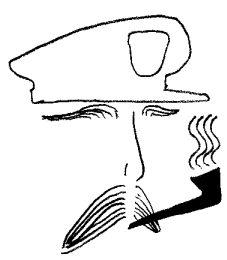
No. 1.—The Battle of Batter Bay.
TRUTHFULLY I WAS a callow young man when I was given my first command, which was many years ago near the end of the last Spanish War. Doubtless it was the influence of my illustrious family, rather than any demonstration of extraordinary ability on my part, that had elevated me to that position. I had been given the sloop Tomtit, which was armed with but a single cannon, though a rather large one, and I frankly admit that neither I nor the other officers expected any great things from me.
Admiral Blanderson had orders to take the island of San Itario, which was of great strategic value owing to the abundant deposits of soapstone in the interior. The fleet that controlled this island would command the cleanest sailors on the seven seas, and such an honor must at all costs belong to our great and glorious King, whom God save.
The only natural harbor in the island, which was otherwise ringed by inaccessible cliffs, was a commodious inlet known as Batter Bay. This was defended by a Spanish fleet of half a dozen well-armed galleons currently anchored in the bay itself. I had instructions to follow our fleet into the bay, and once there to stay out of the way as much as possible; for it was obvious that Admiral Blanderson placed no great confidence in my abilities. The Admiral himself led the fleet in his flagship, the Ineluctable.
The battle commenced as soon as we rounded the head and entered the bay; the Spanish ships hurriedly drew themselves into battle array, and the deafening blasts of the cannon echoed from the surrounding hills. I, however, followed Admiral Blanderson’s orders to the letter, keeping the Tomtit behind our fleet and well clear of the battle, though I commanded my crew of eight to keep our single cannon loaded and ready to fire in case we should unexpectedly come within range of a Spanish ship.
I had, therefore, a certain degree of leisure not shared by the other commanders in our fleet, and I employed that leisure in scanning the land around the bay for enemy installations. You may imagine my horror, then, when I discerned with my keen eye (which is the left one) a perfidious Spaniard (see Fig. 1), well hidden among the trees at the edge of the bay, training a cannon on the prow of the Ineluctable, and preparing to fire on our flagship!

Figure 1.
We attempted to signal the Ineluctable, but all her attention was on the battle opposite, and no one was looking in our direction. The Spanish gun was out of range of our cannon, though perfectly capable of hitting the Ineluctable. There seemed to be nothing I could do: in a few seconds the cannon on shore would blast a hole in the prow of the Ineluctable, doubtless sinking her and Admiral Blanderson with her.
Losing no time, I quickly sent my first mate for paper and pencil. Plotting a trajectory, I quickly calculated how long it would take the shot from the shore to reach our flagship; then I ordered the first mate to train our cannon directly on the prow of the Ineluctable. He almost refused to obey; but I told him in no uncertain terms that, if he rebelled against my authority, I should be very cross with him for the remainder of his service aboard the Tomtit.
We had only moments to aim precisely, and we had only one shot. If we failed, the Admiral would go to his watery grave, and I should be responsible.
Just as we finished maneuvering the cannon into position, a flash from the shore told us that the perfidious Spaniard had fired. Before we even heard the report, I gave the order to fire, and our cannon fired with a deafening blast.
Moments later we saw a puff of dust and debris from the prow of the Ineluctable; but, marvelous to tell, there was no apparent damage. A glance through the spyglass confirmed that my calculations had been perfectly correct. The cannonball from the shore had struck the prow of the ship at exactly the same time as the cannonball from the Tomtit; and the two balls, striking each other with considerable momentum, had fused on the prow of the Ineluctable, forming a strong iron plate where the wood of the hull had been. This was the effect I had calculated. We had saved the Ineluctable.
It did not take the Spaniards very long to figure out what had happened. When they discovered what we had done, they quite naturally surrendered; and this was the end of the last Spanish war. Since then there has been peace with Spain, and for that I do take some credit. I am a modest man, but I merely state what must be regarded as simple fact.